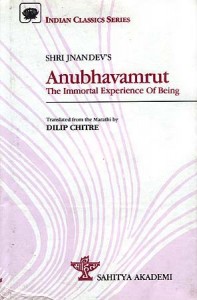SONGS ON YOGA of the MahÄ�rÄ�ṣṭrian NÄ�th Yogis
> Shri Jnandev’s Anubhavamrut: The Immortal Experience of Being <
( One of the Mystic Poet´s of Mahasastra )
> GORAKSHANATH – Origin of Hatha Yoga <
> THE MEDEVIAL SAINTS OF INDIA <
www.proyoga.de – Meine wissenschaftliche Arbeit
Zur Zeit des indischen Mittelalters wanderten in weiten Teilen Indiens und Tibets tantrische Mystiker umher, die Nathas, Nathayogis oder Nathasiddhas genannt wurden. Sie praktizierten und lehrten Hatha- und Kundaliniyoga und hatten großen Einfluss auf das religiöse Leben der Menschen.
In meiner Doktorarbeit habe ich die Lehren und Praktiken dieser Yogis untersucht. Als Textgrundlage dient hierbei ein Werk aus dem ca. 13. Jahrhundert, das Vivekadarpana, wörtlich ‚Spiegel der unterscheidenden Betrachtung‘. In diesem recht umfangreichen Werk (21 Kapitel) wurden die Lehren aus unterschiedlichen philosophischen Schulen, Konzepte und Praktiken diverser tantrischer und yogischer Traditionen, sowie viele mythologische Vorstellungen zusammengetragen.
Die in diesem Werk behandelten Themen sind u.a. ‚das Absolute Bewusstsein‘, ‚die Einzelseele‘, ‚der feinstoffliche Körper‘, ‚die Mikro-Makrokosmos-Korrelation‘, ‚die Guru-Schüler-Beziehung‘, ‚der Siddha‘, ‚der Hatha-Yoga‘, etc. Da sich das Vivekadarpana an den Sadhaka, also den praktizierenden Yogi, richtet, ist es jedoch nicht nur ein philosophisches Werk, denn nach Auffassung der Nathayogis vermittelt Information allein noch keine Erkenntnis oder Einsicht, ganz zu schweigen von einer Transformation des Menschen zum höchsten, allumfassenden Bewußtsein, dem angestrebten Ziel der Nathayogis. Daher ist das Vivekadarpana auch ein praktisches Yogalehrbuch, in dem Ratschläge und Anweisungen zur Yogasadhana (spirituelle Praxis) ihren Platz haben.
Meine Doktorarbeit ist bei der Universitätsbibliothek Heidelberg elektronisch veröffentlicht. Mit der Adresse www.ub.uni-heidelberg.de/archiv/2113 gelangen Sie auf die Hauptseite meiner Veröffentlichung. Hier werden Sie u.a. den Titel und eine kleine Zusammenfassung meiner Arbeit in Englisch und Deutsch vorfinden. Die Doktorarbeit selbst befindet sich in den aufgeführten 32 pdf-Dateien, die Sie downloaden können.
Kashmir Shaivism and the Natha Tradition is related.
by > Matsyendra Nath < :
A number of Indian scientists and Nathas believe that in a system Krama the guru Maheshvarananda, known for his text „Mahartha-manjari“, is Gorakshanath, who is a founder of the Natha Tradition. Besides, everyone knows that Abhinava Gupta mentions Matsyendranath (who is the guru of Gorakshanath) ein Sri Tantraloka as his guru. He also mentions Shambhunath in Tantra-sara as his guru. Shambhunath is not only the main guru of Abhinava Gupta, but he is also known as a guru in the Natha Sampradaya. Kashmir Shaivism synthesized in itself a lot of tantric and shakta methods that had found their place in the Natha Tradition. Guru Gorakshanath also put an emphasis on the inner essence of these teachings, seeing in them a unity of their mystical experience.
Abhinava Gupta as like Gorakshanath, taught one method or the exact methods without method „anupaya”. All other „upayas“ is agents for different types of practitioners. Nathas have the same, all the texts say that there is no Raja Yoga without Hatha and vice versa, there is no difference between Shiva and Shakti.
According to the terms the Nathas much borrowed from Siddhanta of Kashmir Shaivism. Probably, many followers Kashmir Shaivism migrated from Kashmir, dissolved in shakta, natha and buddhist schools. As in the Kashmir Shaivism, in the tradition of Gorakshanath each following tattva contains that from which it emerged itself. Five Shakti, described in one of the major works of Natha Sampradaya (Siddha-Siddhanta Paddhati), identical to those of Shakti, which are described in the tradition of Kashmir Shaivism: Nija-sakti is Chitti-shakti, Para-shakti is Ananda-shakti, Apara-shakti is Ichchha-shakti or Sadashiva tattva, Sukshma-shakti is Jnana-shakti or Ishvara tattva, Kundalini-shakti is Kriya-shakti or Shuddha-Vidya tattva. Three „upayas“ can be correlated as follows: anava with the mantra-yoga and hatha-yoga, shakti with laya-yoga, and shambhava with raja-yoga. The difference is that instead of detailed analysis Suddha and Suddha-ashuddha tattvas the Nathas pay more attention to the theory of the body of Vishesha-purusha and Vyashti-Pinda, but on the other hand, the theory of 6 tattvas is acceptable to nathism.
The > Pratyabhijnya < very close to a doctrine of Nathas, many gurus say that nathism once dissolved and kept in itself a lot of Kashmir Shaivism, such as the principle of Nirupaya by grace (anugraha) of Guru or by shaktipat, etc.
SONGS ON YOGA: texts and teachings of the MahÄ�rÄ�ṣṭrian NÄ�th Yogis: Welcome to the Department of Indian and Tibetan Studies at the Asien-Afrika-Institut
The Asien-Afrika-Institut, situated in the heart of the city, provides students and researchers with ideal circumstances in which to study a multitude of languages and cultures. Read More: > HERE < ,
Comments are closed.
